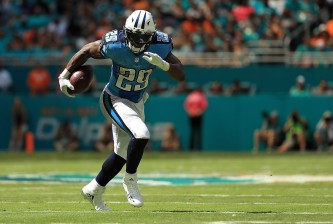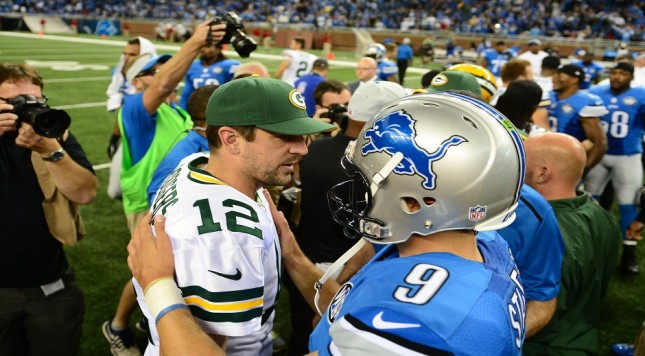The Green Bay Packers kicked off a three-game set against the NFC North on the road against the Detroit Lions. What many thought would be a high-scoring game turned into a defensive showdown, with Detroit emerging as the better team. Let’s take a look at what we learned from the Packers loss.
Playcalling needs to be smarter and more diverse
Three weeks into the season and Mike McCarthy’s game plan continues to hurt the Packers. Detroit’s secondary was missing numerous cornerbacks, and the team was just asking for quick slants, screens and moving players in motion to get favorable matchups. Instead, we saw an offense that kept trying to run the ball into a brick wall of a defensive front and a gameplan that constantly tried to stretch the field, even when it wasn’t there.
If I didn’t botch the math, the #Packers‘ 223 net offensive yards today were the sixth-fewest of Mike McCarthy’s 141 games as coach.
— Jason Wilde (@jasonjwilde) September 22, 2014
A lack of creativity has always been a criticism of McCarthy.
Once the Lions moved a safety over to help cover Jordy Nelson, this team couldn’t move the football. Cobb couldn’t gain separation from press coverage and Jarrett Boykin couldn’t catch the football.
Green Bay needs more balance and their plan of attack needs to change. They can start by moving Cobb around the field to utilize screens and slants to get him open. They can use the draw play to sell the pass and let Eddie Lacy find some yards. McCarthy isn’t a great play caller, but he is a better coach than this and Rodgers is a smarter quarterback.
Green Bay has the weapons to be a great offense, but the game planning and execution of plays must improve. With a road game against the Chicago Bears coming up, the modifications need to be made quickly.
Aaron Rodgers’ inconsistency continues
Talent-wise, Rodgers is arguably the best quarterback in the NFL. But he hasn’t looked like it through three games. His timing with wide receivers, ball placement and decision-making have all been off. Even when you consider the problems on the offensive line and play calling, he must overcome it.
Green Bay had a chance for a comeback—Rodgers had the ball at the Detroit 20 on 4th down and Nelson found a seam, but Rodgers missed the throw which would’ve gone for a touchdown. It was one of several throws Rodgers missed throughout the day and his play was especially poor on third down.
He’s not stepping into his throws to deliver balls on target. One area where Rodgers continues to falter is holding on to the football too long. He relies too heavily on trying to make big throws and when that’s taken away and there is pressure, he will take the sack before he checks it down for a small gain or just throwing it away. This is especially problematic considering Green Bay’s deficiencies on the offensive line and how often he is under pressure.
There were throws when he looked like the best quarterback in football and there was no reason for real concern. As the Packers’ play calling is ironed out and the running game improves, Rodgers will likely revert back to the MVP-caliber player we are familiar with.
Defense shows promise
Ha’Sean Clinton-Dix snagged an interception in the game—the first hauled in by a Packers’ safety in 22 weeks. It was one of three turnovers on the day.
Green Bay’s defense was the big question mark entering the season. On Sunday, it was the defense that kept them in the game. Of the 19 points allowed, the defense was responsible for just one touchdown.
Julius Peppers with the strip sack on Matt Stafford. Recovered the fumble too. Still has plenty left in the tank. — Rand Getlin (@Rand_Getlin) September 21, 2014
The Packers generated pressure on Matthew Stafford throughout the game. Julius Peppers delivered a key strip-sack when Detroit was in the red zone and Green Bay finished with nine quarterback hits.
The secondary also played well—holding Stafford to just 238 yards with three turnovers and a 61.6 QB rating. After over 30 minutes on the field, the defense was exhausted and gave up the 26-yard touchdown dagger.
If Clay Matthews’ groin injury isn’t serious, the Peppers-Matthews combo will be very effective. When you combine that with an improved secondary that can create turnovers and DT Mike Daniels creating pressure in the interior, the defense is good enough to win. Now the heat is on the offense to pick themselves up and reach their potential.
Running game must improve
While there is plenty of blame to place on the shoulders of McCarthy and Rodgers, Lacy has been the biggest disappointment of the season thus far.
While he has played three of the best run defenses in the NFL, 36 carries for 113 through three games is unacceptable. His fumble returned for a touchdown on the second play of the game was also one of the key plays which cost the team on Sunday. Lacy looks more timid with the ball in his hands, failing to show the same power and aggressiveness that helped him excel as a rookie.
Lacy was outplayed by a quicker James Starks against Detroit, as Starks’ burst allowed him to hit holes and pick up yards. But it must be considered that Lacy is running behind a struggling offensive line and has played against some great defensive fronts. RG T.J. Lang has struggled the past two weeks, and Corey Linsley is still adjusting to the NFL. Fortunately, Lang should get back on track and Linsley will improve with more experience.
The return of the running game is key for this offense. Detroit put two safeties deep and loaded the secondary, eliminating passing lanes and forcing the Packers into a bad situation. Once Lacy regains his momentum and starts producing big runs, opposing teams will have to bring the safety down and this will open up bigger plays for Rodgers downfield.
Brandon Bostick and Davante Adams need to see the field more
Would like to see some Brandon Bostick implemented into the offense today, Packers TEs have a combined 4 catches, all by Quarless.
— Kyle Engman (@KyleEngmanNFL) September 21, 2014
While Andrew Quarless was solid against the Lions, he is clearly better served as being a No. 2 tight end. He did manage to get open as Detroit focused on stopping Cobb and Nelson, but Green Bay needs a more athletic player who can slip past linebackers. Bostick is a Jermichael Finley-type, using his speed to find space across the middle to move the chains with short and intermediate gains. He wasn’t targeted against Detroit, but is still recovering from a leg injury, and should emerge soon as the most talented tight end on the roster.
If Green Bay can make the change at tight end, they absolutely need to swap out Boykin for Adams in three-receiver sets. Boykin now has three crucial drops the past two games—the quickest way for a wide receiver to find himself on the bench. Adams had a miscommunication with Rodgers early in the game, but later made up for it and reached back to haul in a high screen pass. Adams was the better receiver last week and he made fewer mistakes against Detroit.
When Green Bay sends out its WR corps next week against Chicago, Adams should take the field with the starters. Bostick and Adams are two weapons that need to become more involved to help pick up this struggling offense.























